Introduction
Showcased alongside the GC-PX1 at CP+ was JVCs new 4K camcorder, which has yet to be given a modelname. The 4K model has a similar exterior shell and body design to JVC's professional GY-HM100U camcorder, but internally it is completely different.
Design & Appearance
{{section_header}}{{section.name}}{{/section_header}}
If you like chatting with friends about funny-looking cameras, you may want to bring up the JVC GC-PX1 at your next meeting. The word "hybrid" does capture the camera's style quite well, as it simultaneously has the design of both a camera and a camcorder. The lens barrel on the front looks like it was absconded from a JVC camcorder, while the back of the PX1 has the design of a traditional digital camera (as does the right side grip). Safe to say, the GC-PX1 is an unusual product in terms of its looks. Pictures tell this story the best, though, so check through the product shots below to get a better idea of what we're talking about.
Tour
{{section_header}}{{section.name}}{{/section_header}}




Ease of Use
{{section_header}}{{section.name}}{{/section_header}}
The GC-PX1 feels and functions more like a JVC camcorder than a traditional camera, so if you have camcorder experience you may find the PX1 more familiar. The hybrid nature of the device can make it a bit difficult to use, however, particularly if you continually switch between photo and video mode. Many of the settings work in both modes, but they occasionally have different names or labels, and that can be confusing. Things are made even more complicated by the fact that the PX1 has a ton of features and a very unusual design.
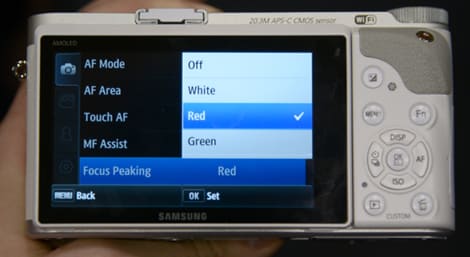
The menu design on the PX1 is taken straight from JVC's camcorders. The layout is decent, the navigation isn't bad, and there is a little info box at the bottom of the screen to give you advice or tips about the menu options you have selected. We must admit, using the touchscreen on the PX1 is better than the Laser Touch system on JVC's camcorders of yore, but it is still somewhat frustrating for navigating the long menus.

Size & Handling
{{section_header}}{{section.name}}{{/section_header}}
The overall dimensions of the GC-PX1 are 131 x 67 x 122mm, but that doesn't really paint a good picture of the camera. Just look at a few of our photos of the camera and you'll see what we're talking about. The PX1 is very thin on the back and left side, but it has a long lens barrel that extends out a good five or six inches from the rest of the camera. The grip on the right side is big, and it is easy to wrap your hands around, but it feels a bit strange. It doesn't feel as meaty as the grips on, say, a DSLR camera—which the design of the GC-PX1 somewhat resembles.
The weight of the PX1 is around 515g when it is fully loaded with a battery pack. This means you're likely to feel most comfortable if you're holding the camera with two hands. Holding the camera like this, with one hand wrapped around the right-side grip and another under the front of the lens for balance, feels good. It's similar to the way most people hold DSLRs or professional camcorders. What we really want, though, is a nice thick lens ring around the front of the camera. Since your hand is already going to be there for balance, why not add an easily-accessible control there as well? This is the camera's major handling flaw, as the control dial on the left side is neither comfortable to use nor well designed.

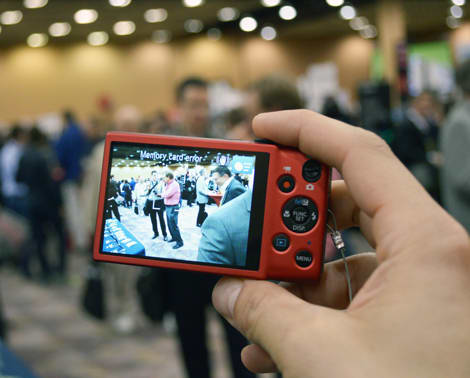
Auto Mode
{{section_header}}{{section.name}}{{/section_header}}
The mode dial on the left side of the GC-PX1 is setup just like you'd see on a camera. There are options for shutter and aperture-priority, full manual modes, scene modes, and an iAuto setting. The auto mode works similarly in both photo and video recording, but it does have some strange quirks. In video mode, we found the auto focus to be a lot slower than most camcorders, while the autofocus in photo mode worked without any major problems. Auto exposure was also often slow, but at least it was very smooth in its adjustments.
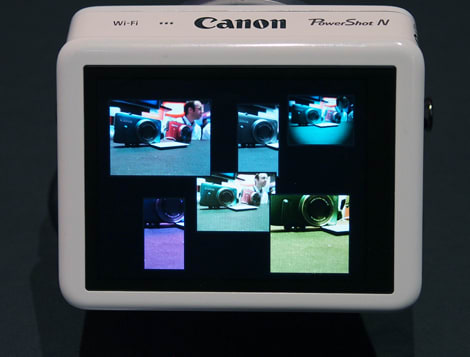
Movie Mode
{{section_header}}{{section.name}}{{/section_header}}
The GC-PX1 is just as much of a camera as it is a camcorder, so we could go on and on for an entire review about its movie mode features. We'll try to keep it as short as possible, though, because this is Digital_Camera_Info.com after all.
Let's begin with the recording resolution options. The camera's Full HD setting records a 1920 x 1080 image with a 60p frame rate. There's also a 720/60p record mode and an iFrame setting, which is used to capture footage that is compatible with Apple's iMovie software. The 1080/60p setting is the only record mode that is really deserving of fanfare, as Full HD 60p recording is still rather rare for consumer cameras and camcorders. 2011 appears to be a big year for 60p recording, however, as new Sony models are now offering this feature (along with Panasonic camcorders and, like the GC-PX1, some JVC models).
All videos recorded with the GC-PX1 are compressed using the MPEG-4 codec. The camera does not use AVCHD compression because AVCHD cannot accommodate 1080/60p recording. With the 1080/60p record mode, the camera offers two quality settings: UHR and HR. The UHR mode records at a ridiculously-high 36Mbps bitrate, which is far higher than the 24Mbps bitrate most consumer camcorders top out with (24Mbps is the highest bitrate allowed with AVCHD compression).
In addition to the regular move modes discussed above, the camera also has a 300fps high-speed record mode. This setting does not record HD video, as its resolution is a measly 640 x 360, but the resultant video is turned out in super slow motion. This makes it ideal for capturing intense action moments or for analyzing things like golf swings in slow motion.
That's not all. The camera also has a time lapse record function that can be set to automatically record clips of various lengths at various intervals, and there's an auto record feature that starts recording when the camera spots a subject moving within the frame. There are a number of audio settings on the camera, including wind cut and mic level adjustment, both of which can be used in video mode.
Custom Image Presets
{{section_header}}{{section.name}}{{/section_header}}
Scene modes on the GC-PX1, which work in both video and still image modes, include the following: Portrait, Soft Skin, Landscape, Landscape and Portrait, Night, Night Alive, Snow, Beach, Sports, Spotlight, Fireworks, and Sunset.
Drive/Burst Mode
{{section_header}}{{section.name}}{{/section_header}}
We mentioned the high speed recording option in video mode that uses a 300fps frame rate to capture slow motion video, but the camera also has a continuous shooting mode for stills as well. The continuous shooting mode, which JVC calls "High-speed Motor Drive Shooting," allows you to take 6-megapixel still images continuously (during video recording). You can take 60 shots per second and up to 144 consecutive shots in this mode. In photo mode there is another continuous shot function that can be set to speeds of low, medium, or high. Auto exposure bracketing is a feature in photo mode as well.
Manual Controls
{{section_header}}{{section.name}}{{/section_header}}
The GC-PX1 has a bunch of manual controls in both video and photo mode. In order to access most controls, you must switch to A, P, or M mode on the mode dial. The confusing part of all this is that the control range is different depending on whether you are shooting video or photos with the camera.
Also somewhat frustrating is the design of the camera's control dial that is used to adjust manual settings. The control dial is not in the best location and it doesn't rotate with precision. We'd much prefer to have a large lens ring on the front of the camera that would line up well when you hold the lens with your left hand.

Focus
{{section_header}}{{section.name}}{{/section_header}}
Focus on the GC-PX1 can be set manually using the aforementioned control dial, but, like we said, the dial doesn't do a very good job. The small size of the dial makes it difficult to focus precisely most of the time, although the camera does provide focus assist features to help you.
ISO
{{section_header}}{{section.name}}{{/section_header}}
ISO can be set in photo mode with options for 100, 200, 400, 800, 1600, 3200, and 6400. In video mode, the same adjustment is called Gain, but the options are a bit different. You can set Gain to auto, off, +6, +12, or +18. There aren't as many increments for adjustment in video mode as there is in photo mode, but other than that Gain and ISO control are essentially the same thing.
Aperture & Shutter Speed
{{section_header}}{{section.name}}{{/section_header}}
Aperture and shutter speed each have their own priority modes on the GC-PX1 (labeled with an A and an S on the mode dial). You can also adjust these settings in the camera's full manual mode. For shutter speed, the range of adjustment is different depending on whether you're recording video or taking photos. In photo mode, you can set the shutter speed anywhere from 1/2 of a second to 1/125. In video mode, the range is much larger, from 1/2 all the way up to 1/4000 of a second.
Like focus, both shutter speed and aperture can be set with the adjustment dial on the left side of the camera. You can also set these controls with the touchscreen interface. Both of these systems are less than perfect when it comes to precision, accuracy, and comfort.
White Balance
{{section_header}}{{section.name}}{{/section_header}}
White balance controls are not extensive on the camera, but the important thing is that you can set white balance manually. In addition to using the few preset options (Halogen, Fluorescent 1, and Fluorescent 2).
Exposure & Metering
{{section_header}}{{section.name}}{{/section_header}}
Exposure control is one of those funny features where the adjustment range is slightly different in video mode as it is in photo mode on the GC-PX1. The thing that's really strange is that the controls are actually the same in both modes, it's just the JVC makes them appear different. Here's what we mean: in photo mode you can adjust exposure from -2 to +2 in 1/3 EV increments for a total of 13 intervals. In video mode the range is -6 to +6 in 1 EV steps, which is also a total of 13 intervals. So, the amount of adjustment is identical in both modes, but JVC displays the range differently depending on what mode you're in. Kind of confusing for no good reason.
Image Stabilization
{{section_header}}{{section.name}}{{/section_header}}
JVC's specs for the GC-PX1 list the camera as having optical image stabilization, but the camera's menu system doesn't mention this feature. It shows the stabilization options as being digital (DIS) and advanced. We assume that JVC is correct when it says the system is optical, but the camera must have a digital system as well. Either way, the GC-PX1 is definitely equipped with some kind of stabilization system, and the feature works in both video and photo mode.
Picture Quality & Size Options
{{section_header}}{{section.name}}{{/section_header}}
The largest photo size option on the camera is a 10-megapixel, 3648 x 2736 setting. There are a number of other size options in the 4:3 aspect ratio as well as the 16:9 aspect ratio (the biggest 16:9 mode is a 3648 x 2056 resolution image). You can capture photos in video mode, but only at the 3200 x 1800 size option. In all photo modes you have quality options of fine or standard.
Other Controls
LCD
{{section_header}}{{section.name}}{{/section_header}}
The GC-PX1 has a well-sized 3-inch LCD on its back side. Even though we don't mind the size of the screen, we do have an issue with its 230,000-pixel resolution. This is simply too low of a resolution for a modern-day camera, particularly when we're used to seeing pixel counts of 900,000+ on many new cameras and camcorders.
The LCD on the GC-PX1 does pivot, but it only does so in an up and down manner (with its hinges at the top of the camera). This ability to angle is better than having a stationary LCD, but it isn't as solid as the flip-out screens you find on most camcorders and some cameras. The LCD also has a touchscreen interface.

Flash
{{section_header}}{{section.name}}{{/section_header}}
The built-in flash on the GC-PX1 rests to the left side of the lens, and it has a recommended range of 2 meters or less according to JVC's specs.

Lens & Sensor
{{section_header}}{{section.name}}{{/section_header}}
The camera is equipped with an f/2.8 lens with a focal range of 6.7mm to 67mm. The lens has a filter thread of 46mm, which is used to attach lens accessories or adapters. In both video and photo mode, the lens has a 10x optical zoom capability.
The sensor on the GC-PX1 is a 1/2.3-inch CMOS with 10.62 total megapixels. The effective pixel count for the camera is 5.76 megapixels for videos and 9.98 megapixels for still images. JVC also touts the PX1 as having its new Falconbrid processor, which is why the camera allows for its high recording bitrate in the 1080/60p video mode. The new processor also helps with the high-speed photo modes and the still image encoding.

Jacks, Ports & Plugs
{{section_header}}{{section.name}}{{/section_header}}
JVC smartly put all of the GC-PX1's ports in one collective row on the left side of the camera. This makes the ports easy to find and access. From left to right, the ports are: 3.5mm mic input, AV/headphone-out, USB, HDMI, and DC-input. The only "port" not located in this collection is the accessory shoe that is on the top of the camera.
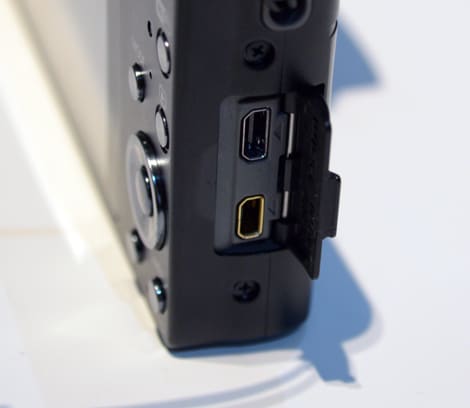
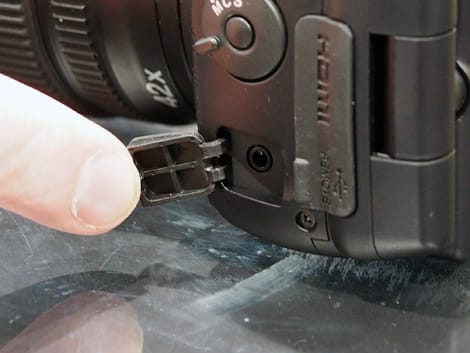
Battery
{{section_header}}{{section.name}}{{/section_header}}
The battery compartment is inside the right-side grip on the GC-PX1. We couldn't actually open the battery compartment on the camera we got to play with at the CP+ trade show (it seems like JVC had locked all the battery compartments so they couldn't be tampered with), but this is where the battery goes. There's a little battery release switch that should open the compartment door when you press it. The camera comes with a BN-VF815 rechargeable battery pack.

Memory
{{section_header}}{{section.name}}{{/section_header}}
Most cameras do not come with internal memory, but since the GC-PX1 takes a lot of its features from the camcorder industry, it actually comes with 32GB of internal flash. You can expand the amount of memory on the camera by inserting SD, SDHC, or SDXC cards into the memory card slot on the right side of the PX1.
{{product.manufacturer_specs['FI Memory Photo']}}
Conclusion
In our hands-on look at the GC-PX1 at the CP+ show in Yokohama, Japan, we were impressed by the camera's dual nature. The camera doesn't have the best handling, and it certainly won't win awards for design anytime soon, but its unique blend of video and photo features is interesting.
In all, we're actually more impressed with the GC-PX1 as a camcorder than as a camera, and that makes sense—after all, JVC is manufacturer of camcorders first and foremost. The GC-PX1's 1080/60p record mode sounds good on paper, and it is still a relatively new and unique feature for a camcorder to offer (although it is cropping up on a bunch of new models in 2011). In comparison, the PX1's photo specs are less noteworthy and original.
We're not sure if the PX1's strange design will be able to win over new users, and we also don't know if a hybrid photo/video camera is really what people are looking for at this time. In a way, the PX1 is trying to capitalize on the video-capable DSLR craze by providing a camera with very strong video capabilities. Unfortunately, however, it lacks an interchangeable lens system, which is something that will likely hurt the PX1's prospects.
Sample Photos
{{section_header}}{{section.name}}{{/section_header}}
Specs
{{manufacturer_specs_table}}
Meet the tester
Jeremy is the video expert of our imaging team and Reviewed.com's head of video production. Originally from Pennsylvania and upstate NY, he graduated from Bard college with a degree in film and electronic media. He has been living and working in New England since 2005.
Checking our work.
Our team is here to help you buy the best stuff and love what you own. Our writers, editors, and experts obsess over the products we cover to make sure you're confident and satisfied. Have a different opinion about something we recommend? Email us and we'll compare notes.
Shoot us an email